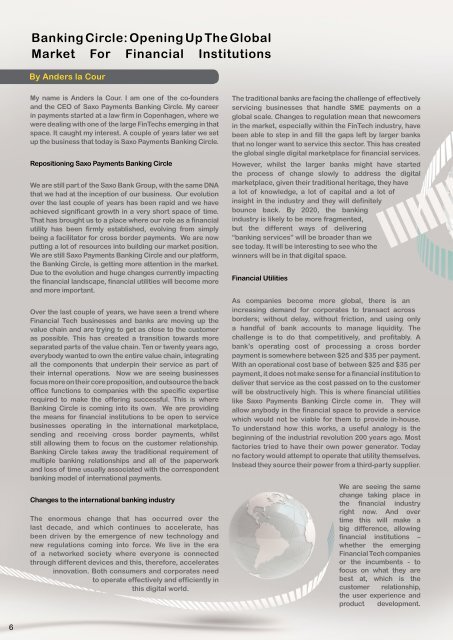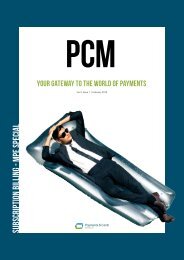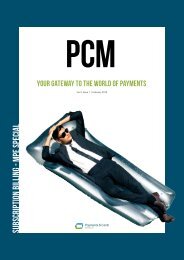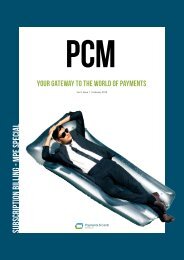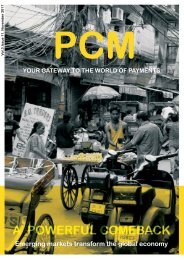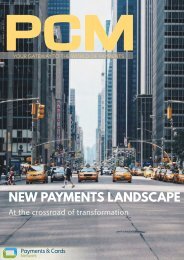PCM Vol.3 Issue 12
In this issue, we will explore the development of eCommerce, the upcoming trends in 2018 and the key challenges eCommerce merchants face trying to keep up with the fast-paced changes.
In this issue, we will explore the development of eCommerce, the upcoming trends in 2018 and the key challenges eCommerce merchants face trying to keep up with the fast-paced changes.
You also want an ePaper? Increase the reach of your titles
YUMPU automatically turns print PDFs into web optimized ePapers that Google loves.
Banking Circle: Opening Up The Global<br />
Market For Financial Institutions<br />
By Anders la Cour<br />
My name is Anders la Cour. I am one of the co-founders<br />
and the CEO of Saxo Payments Banking Circle. My career<br />
in payments started at a law firm in Copenhagen, where we<br />
were dealing with one of the large FinTechs emerging in that<br />
space. It caught my interest. A couple of years later we set<br />
up the business that today is Saxo Payments Banking Circle.<br />
Repositioning Saxo Payments Banking Circle<br />
We are still part of the Saxo Bank Group, with the same DNA<br />
that we had at the inception of our business. Our evolution<br />
over the last couple of years has been rapid and we have<br />
achieved significant growth in a very short space of time.<br />
That has brought us to a place where our role as a financial<br />
utility has been firmly established, evolving from simply<br />
being a facilitator for cross border payments. We are now<br />
putting a lot of resources into building our market position.<br />
We are still Saxo Payments Banking Circle and our platform,<br />
the Banking Circle, is getting more attention in the market.<br />
Due to the evolution and huge changes currently impacting<br />
the financial landscape, financial utilities will become more<br />
and more important.<br />
Over the last couple of years, we have seen a trend where<br />
Financial Tech businesses and banks are moving up the<br />
value chain and are trying to get as close to the customer<br />
as possible. This has created a transition towards more<br />
separated parts of the value chain. Ten or twenty years ago,<br />
everybody wanted to own the entire value chain, integrating<br />
all the components that underpin their service as part of<br />
their internal operations. Now we are seeing businesses<br />
focus more on their core proposition, and outsource the back<br />
office functions to companies with the specific expertise<br />
required to make the offering successful. This is where<br />
Banking Circle is coming into its own. We are providing<br />
the means for financial institutions to be open to service<br />
businesses operating in the international marketplace,<br />
sending and receiving cross border payments, whilst<br />
still allowing them to focus on the customer relationship.<br />
Banking Circle takes away the traditional requirement of<br />
multiple banking relationships and all of the paperwork<br />
and loss of time usually associated with the correspondent<br />
banking model of international payments.<br />
Changes to the international banking industry<br />
The enormous change that has occurred over the<br />
last decade, and which continues to accelerate, has<br />
been driven by the emergence of new technology and<br />
new regulations coming into force. We live in the era<br />
of a networked society where everyone is connected<br />
through different devices and this, therefore, accelerates<br />
innovation. Both consumers and corporates need<br />
to operate effectively and efficiently in<br />
this digital world.<br />
The traditional banks are facing the challenge of effectively<br />
servicing businesses that handle SME payments on a<br />
global scale. Changes to regulation mean that newcomers<br />
in the market, especially within the FinTech industry, have<br />
been able to step in and fill the gaps left by larger banks<br />
that no longer want to service this sector. This has created<br />
the global single digital marketplace for financial services.<br />
However, whilst the larger banks might have started<br />
the process of change slowly to address the digital<br />
marketplace, given their traditional heritage, they have<br />
a lot of knowledge, a lot of capital and a lot of<br />
insight in the industry and they will definitely<br />
bounce back. By 2020, the banking<br />
industry is likely to be more fragmented,<br />
but the different ways of delivering<br />
“banking services” will be broader than we<br />
see today. It will be interesting to see who the<br />
winners will be in that digital space.<br />
Financial Utilities<br />
As companies become more global, there is an<br />
increasing demand for corporates to transact across<br />
borders; without delay, without friction, and using only<br />
a handful of bank accounts to manage liquidity. The<br />
challenge is to do that competitively, and profitably. A<br />
bank’s operating cost of processing a cross border<br />
payment is somewhere between $25 and $35 per payment.<br />
With an operational cost base of between $25 and $35 per<br />
payment, it does not make sense for a financial institution to<br />
deliver that service as the cost passed on to the customer<br />
will be obstructively high. This is where financial utilities<br />
like Saxo Payments Banking Circle come in. They will<br />
allow anybody in the financial space to provide a service<br />
which would not be viable for them to provide in-house.<br />
To understand how this works, a useful analogy is the<br />
beginning of the industrial revolution 200 years ago. Most<br />
factories tried to have their own power generator. Today<br />
no factory would attempt to operate that utility themselves.<br />
Instead they source their power from a third-party supplier.<br />
We are seeing the same<br />
change taking place in<br />
the financial industry<br />
right now. And over<br />
time this will make a<br />
big difference, allowing<br />
financial institutions –<br />
whether the emerging<br />
Financial Tech companies<br />
or the incumbents - to<br />
focus on what they are<br />
best at, which is the<br />
customer relationship,<br />
the user experience and<br />
product development.<br />
6


